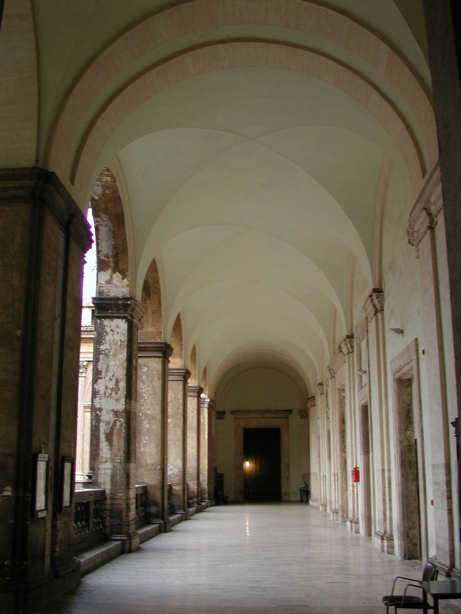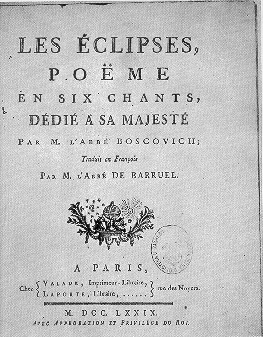|
Giuseppe Calandrelli
Giuseppe Calandrelli (22 May 1749 – 24 December 1827) was an Italian priest, astronomer and mathematician. He founded the first astronomical observatory in the Collegio Romano in 1787. An uncle of the astronomer Ignazio Calandrelli, he was among the first to observe the parallax of stars, estimate the masses of comets, the potential size of their atmosphere, and to examine the use of barometers to mathematically estimate altitudes. Biography Calandrelli was born at Zagarolo, near Rome, son of Tommasso and Maria Fortini. He studied philosophy and theology at Vatican and Albano and was ordained priest in 1768 under Cardinal Flavio Chigi. He taught at the Magliano Sabina seminary from 1769. In 1773 the Society of Jesus was suppressed by Pope Clement XIV and Calandrelli was posted as a professor of mathematics at the Collegio Romano. With support of Cardinal Francesco Saverio de Zelada (1717–1801) who trained him at his own private observatory, he tried to set up an observator ... [...More Info...] [...Related Items...] OR: [Wikipedia] [Google] [Baidu] |
Zagarolo
Zagarolo is a town and ''comune'' in the Metropolitan City of Rome, in the region of Lazio of central Italy. It lies southeast of Rome, and it borders the municipalities of Colonna, Gallicano nel Lazio, Monte Compatri, Palestrina, Rome, San Cesareo (former frazione of Zagarolo). Zagarolo's town center lies on a very narrow tuff hill, long and about wide, at an elevation of , surrounded by green valleys. The southern continuation of an important pilgrim route, the Via Francigena passes through the Zagarolo countryside. History Zagarolo may have origins in Gabii, an ancient city founded in the 5th century, and sited a few kilometers from Zagarolo. Official site of the town of Zagarolo (in Italian) It was an ancient Roman town and there are remains of a |
Ignazio Calandrelli
Ignazio Calandrelli (22 November 1792 – 12 February 1866) was an Italian priest and observational astronomer. He was the nephew of Giuseppe Calandrelli. His main work was in the observations and examinations of the movements of planets and comets. Calandrelli was born in Rome to Carlo and Margarita Girella and was the nephew of the astronomer Giuseppe Calandrelli. He studied theology and joined the Gregorian University, receiving a degree in philosophy in 1814 when he became a student of his uncle at the Collegio Romano observatory. He was then appointed professor of elementary mathematics and then taught at the Saint Apollinare seminary. In 1838 he became professor of optics and astronomy at Rome and in 1845 took charge of the Bologna Observatory. In 1848 he became director of the Campidoglio observatory. A Merz achromatic telescope (11.4–cm ”aperture, 190–cm focal length) was donated to the observatory by Marquis Giuseppe Ferrajoli (1798–1870) in 1869. He published obs ... [...More Info...] [...Related Items...] OR: [Wikipedia] [Google] [Baidu] |
Priest
A priest is a religious leader authorized to perform the sacred rituals of a religion, especially as a mediatory agent between humans and one or more deities. They also have the authority or power to administer religious rites; in particular, rites of sacrifice to, and propitiation of, a deity or deities. Their office or position is the 'priesthood', a term which also may apply to such persons collectively. A priest may have the duty to hear confessions periodically, give marriage counseling, provide prenuptial counseling, give spiritual direction, teach catechism, or visit those confined indoors, such as the sick in hospitals and nursing homes. Description According to the trifunctional hypothesis of prehistoric Proto-Indo-European society, priests have existed since the earliest of times and in the simplest societies, most likely as a result of agricultural surplus and consequent social stratification. The necessity to read sacred texts and keep temple or church rec ... [...More Info...] [...Related Items...] OR: [Wikipedia] [Google] [Baidu] |
Astronomer
An astronomer is a scientist in the field of astronomy who focuses their studies on a specific question or field outside the scope of Earth. They observe astronomical objects such as stars, planets, moons, comets and galaxies – in either observational (by analyzing the data) or theoretical astronomy. Examples of topics or fields astronomers study include planetary science, solar astronomy, the origin or evolution of stars, or the formation of galaxies. A related but distinct subject is physical cosmology, which studies the Universe as a whole. Types Astronomers usually fall under either of two main types: observational and theoretical. Observational astronomers make direct observations of celestial objects and analyze the data. In contrast, theoretical astronomers create and investigate models of things that cannot be observed. Because it takes millions to billions of years for a system of stars or a galaxy to complete a life cycle, astronomers must observe snapsh ... [...More Info...] [...Related Items...] OR: [Wikipedia] [Google] [Baidu] |
Roman College
The Roman College ( la, Collegium Romanum, it, Collegio Romano) was a school established by St. Ignatius of Loyola in 1551, just 11 years after he founded the Society of Jesus (Jesuits). It quickly grew to include classes from elementary school through university level and moved to several successive locations to accommodate its burgeoning student population. With the patronage of Pope Gregory XIII, the final seat of the Roman College was built in 1584 near the center of Rome's most historic Pigna district, on what today is called Piazza del Collegio Romano, adding the church of St. Ignatius in 1626, and a renowned observatory in 1787. The college remained at this location for 286 years until the revolutionary Capture of Rome in 1870.In 1870, the new Italian government confiscated the property of the university and their building (that eventually became the Ennio Quirino Visconti Liceo Ginnasio), which forced the university to transfer to the Palazzo Gabrielli-Borromeo on the Vi ... [...More Info...] [...Related Items...] OR: [Wikipedia] [Google] [Baidu] |
Stellar Parallax
Stellar parallax is the apparent shift of position of any nearby star (or other object) against the background of distant objects, and a basis for determining (through trigonometry) the distance of the object. Created by the different orbital positions of Earth, the extremely small observed shift is largest at time intervals of about six months, when Earth arrives at opposite sides of the Sun in its orbit, giving a baseline distance of about two astronomical units between observations. The parallax itself is considered to be half of this maximum, about equivalent to the observational shift that would occur due to the different positions of Earth and the Sun, a baseline of one astronomical unit (AU). Stellar parallax is so difficult to detect that its existence was the subject of much debate in astronomy for hundreds of years. Thomas Henderson, Friedrich Georg Wilhelm von Struve, and Friedrich Bessel made first successful parallax measurements in 1832-1838, for the stars alph ... [...More Info...] [...Related Items...] OR: [Wikipedia] [Google] [Baidu] |
Roger Joseph Boscovich
Roger Joseph Boscovich ( hr, Ruđer Josip Bošković; ; it, Ruggiero Giuseppe Boscovich; la, Rogerius (Iosephus) Boscovicius; sr, Руђер Јосип Бошковић; 18 May 1711 – 13 February 1787) was a physicist, astronomer, mathematician, philosopher, diplomat, poet, theologian, Jesuit priest, and a polymath from the Republic of Ragusa.Biography: Roger Joseph Boscovich, S.J. Fairchild University website. He studied and lived in Italy and France where he also published many of his works. Boscovich produced a precursor of and made many contributions to |
Angelo Secchi
Angelo Secchi (; 28 June 1818 – 26 February 1878) was an Italian Catholic priest, astronomer from the Italian region of Emilia. He was director of the observatory at the Pontifical Gregorian University (then called the Roman College) for 28 years. He was a pioneer in astronomical spectroscopy, and was one of the first scientists to state authoritatively that the Sun is a star. Biography Secchi was born in Reggio Emilia, where he studied at the Jesuit gymnasium. At the age of 16, he entered the Jesuit Order in Rome. He continued his studies at the Roman College, and demonstrated great scientific ability. In 1839, he was appointed tutor of mathematics and physics at the college. In 1841, he became professor of physics at the Jesuit College in Loreto. In 1844, he began theological studies in Rome, and was ordained a priest on 12 September 1847. In 1848, due to the Roman Revolution, the Jesuits were ordered to leave Rome. Angelo Secchi spent the next two years in the Uni ... [...More Info...] [...Related Items...] OR: [Wikipedia] [Google] [Baidu] |
Euler's Identity
In mathematics, Euler's identity (also known as Euler's equation) is the equality e^ + 1 = 0 where : is Euler's number, the base of natural logarithms, : is the imaginary unit, which by definition satisfies , and : is pi, the ratio of the circumference of a circle to its diameter. Euler's identity is named after the Swiss mathematician Leonhard Euler. It is a special case of Euler's formula e^ = \cos x + i\sin x when evaluated for . Euler's identity is considered to be an exemplar of mathematical beauty as it shows a profound connection between the most fundamental numbers in mathematics. In addition, it is directly used in a proof that is transcendental, which implies the impossibility of squaring the circle. Mathematical beauty Euler's identity is often cited as an example of deep mathematical beauty. Three of the basic arithmetic operations occur exactly once each: addition, multiplication, and exponentiation. The identity also links five fundamental mathematical constan ... [...More Info...] [...Related Items...] OR: [Wikipedia] [Google] [Baidu] |
Vega
Vega is the brightest star in the northern Northern may refer to the following: Geography * North, a point in direction * Northern Europe, the northern part or region of Europe * Northern Highland, a region of Wisconsin, United States * Northern Province, Sri Lanka * Northern Range, a ra ... constellation of Lyra. It has the Bayer designation α Lyrae, which is Latinisation of names, Latinised to Alpha Lyrae and abbreviated Alpha Lyr or α Lyr. This star is List of star systems within 25–30 light-years, relatively close at only from the Sun, and one of the most luminous stars in the solar neighborhood, Sun's neighborhood. It is the list of brightest stars, fifth-brightest star in the night sky, and the second-brightest star in the northern celestial hemisphere, after Arcturus. Vega has been extensively studied by astronomers, leading it to be termed "arguably the next most important star in the sky after the Sun". Vega was the North Star, northern pole star arou ... [...More Info...] [...Related Items...] OR: [Wikipedia] [Google] [Baidu] |
1749 Births
Events January–March * January 3 ** Benning Wentworth issues the first of the New Hampshire Grants, leading to the establishment of Vermont. ** The first issue of '' Berlingske'', Denmark's oldest continually operating newspaper, is published. * January 21 – The Teatro Filarmonico, the main opera theater in Verona, Italy, is destroyed by fire. It is rebuilt in 1754. * February – The second part of John Cleland's erotic novel '' Fanny Hill'' (''Memoirs of a Woman of Pleasure'') is published in London. The author is released from debtors' prison in March. * February 28 – Henry Fielding's comic novel '' The History of Tom Jones, a Foundling'' is published in London. Also this year, Fielding becomes magistrate at Bow Street, and first enlists the help of the Bow Street Runners, an early police force (eight men at first). * March 6 – A "corpse riot" breaks out in Glasgow after a body disappears from a churchyard in the Gorbals district ... [...More Info...] [...Related Items...] OR: [Wikipedia] [Google] [Baidu] |
1827 Deaths
Eighteen or 18 may refer to: * 18 (number), the natural number following 17 and preceding 19 * one of the years 18 BC, AD 18, 1918, 2018 Film, television and entertainment * ''18'' (film), a 1993 Taiwanese experimental film based on the short story ''God's Dice'' * ''Eighteen'' (film), a 2005 Canadian dramatic feature film * 18 (British Board of Film Classification), a film rating in the United Kingdom, also used in Ireland by the Irish Film Classification Office * 18 (''Dragon Ball''), a character in the ''Dragon Ball'' franchise * "Eighteen", a 2006 episode of the animated television series '' 12 oz. Mouse'' Music Albums * ''18'' (Moby album), 2002 * ''18'' (Nana Kitade album), 2005 * '' 18...'', 2009 debut album by G.E.M. Songs * "18" (5 Seconds of Summer song), from their 2014 eponymous debut album * "18" (One Direction song), from their 2014 studio album ''Four'' * "18", by Anarbor from their 2013 studio album ''Burnout'' * "I'm Eighteen", by Alice Cooper common ... [...More Info...] [...Related Items...] OR: [Wikipedia] [Google] [Baidu] |







